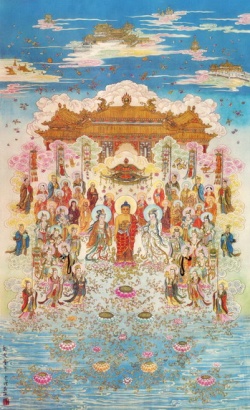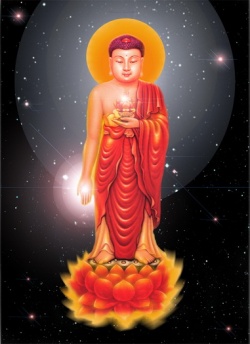Ryonin and the Yuzu Nembutsu
Recently, I was contacted by a colleague, “R”, I knew back on E-Sangha1 asking for language-translation help to read this website. This website belongs to a temple called Dainenbutsuji (大念沸寺).
This is the head temple of the Japanese Buddhist sect called the Yūzū Nembutsu Shū (融通念佛宗), which is a very interesting Pure Land Buddhist sect with some parallels to the more widely known Jodo Shu and Jodo Shinshu sects.
The sect was founded by a monk of the then powerful and state-sanctioned Tendai sect named Ryōnin (良忍) (1072-1132). Ryonin lived at a time when Tendai Buddhism had absorbed a great deal of Pure Land Buddhist teachings from China, but the practices were still not widespread outside of the aristocracy at the Heian court, or among monks themselves. So, a number of monks tried to bring Buddhism to a wider audience, including Ryonin.
Ryonin was deeply influenced by Huayan thinking from China, based in turn on the Flower Garland Sutra (kegonkyō, 華厳経), which is a very long and difficult text, but stresses the importance of interdependence. All phenomena, all things and people, exist only in relation to every other thing, like the glittering nodes in the Jewel Net of Brahma.
Ryonin surmised that when one practices Pure Land Buddhism, and recites the nembutsu (Amitabha Buddha’s name), it benefits the whole world.
Thus he called it yūzū nembutsu (融通念仏) or “circulating nembutsu”. The idea is both brilliant, and at the same time sensible. If reciting the nembutsu helps to make one a better person, by virtue of Amida Buddha’s compassion and light, this kind of “rubs off” on others, who in turn pass on the “good vibes” until it benefits everyone in the long-run.
I think I am over-simplifying things quite a bit, but Ryonin’s teaching emphasizes the fact that all beings are related to each other, and what we do has a profound impact on others, for better or for worse.
So, as the Pure Land teachings became popular among the general public, Ryonin combined this with the wisdom of Huayan Buddhism to make one’s personal practice have more meaning and benefit.
It exemplifies the beauty of Pure Land Buddhism, plus the profound wisdom of the Flower Garland Sutra teachings.
Still, I think Ryonin was a bit ahead of his time, and the Yuzu Nembutsu sect is not that large as an institution.
However, Ryonin’s ideas, and the synthesis of Huayan and Pure Land Buddhism appear again and again in later generations. Shinran, founder of Jodo Shinshu Buddhism, takes the same teachings, but offers a different spin on them.
Where Ryonin emphasizes the practice as embodying the Huayan teachings, Shinran taught that the nembutsu was an acknowledgment of the fact that Amida Buddha himself is the embodiment of the Huayan teachings. You can see this for example in the famous passage in the “Commentaries on ‘Notes on the Essentials of Faith Alone’” which states:
Nirvana has innumerable names. It is impossible to give them in detail; I will list only a few. Nirvana is called extinction of passions, the uncreated, peaceful happiness, eternal bliss, true reality, dharma-body, dharma-nature, suchness, oneness, and Buddha-nature.
Buddha-nature is none other than Tathagata (Amida Buddha).
This Tathagata pervades the countless worlds; it fills the hearts and minds of the ocean of all beings. Thus, plants, trees, and land all attain Buddhahood.
I think both Ryonin and Shinran arrive at almost the same teachings, even if they differ on emphasis, but it’s fascinating to see both minds at work.
Anyway, getting back to the Yuzu Nembutsu sect, the head temple’s website has some interesting sections, though none of it in English. I can honestly only read small parts, but one part I liked was this page, which included some sound files for liturgy in the Yuzu Nembutsu sect. The liturgy is actually quite familiar to those of the Tendai or Jodo Sects.
The first purple button is the Shiseige hymn (called Juseige in Shinshu), posted on my blog. I am not sure what the second button is, but the third button is a special, melodic recitation of the nembutsu.
The 甲 kanji (“kan”) means things like a high voice, or high-class. So, the nembutsu here is slow, and very melodic.
I am not sure if it’s related to the famous “five-tone nembutsu” style developed by the Chinese Pure Land master Fa-chao (Fǎ Zhào, 法照),2 centuries earlier and popularized in Tendai practices by Ennin in the 9th (?) century in Japan. It certainly might be the same one, but others with more knowledge can help shed light on the subject.
Anyway, I helped out my colleague a little, though not enough, but I learned a lot from the experience.
Pure Land Buddhism is a complex branch of Buddhism, and not something I think Buddhist text books do justice for. Lots of ideas, strains of thoughts, and ways to look at the nembutsu, the Pure Land and Amitabha/Shakyamuni. Hopefully you learned something like I did! Enjoy!
P.S. Trying out the four-post week schedule again (Sun, Mon, Wed and Fri), for a while again. Got a lot of stuff lined up I hope readers enjoy. :)
1 I left E-sangha months ago as I got tired of certain conflicts there between defenders and detractors, and I decided to focus more on Buddhism in the “meat-world” as a certain online friend described it.
This seems to have reflected in subtle changes to the blog, as I have come to realize. I am definitely happier these days. :)
2 I prefer Pinyin over Wade-Giles romanization, but W.G. is still the most widely used. The “zh” in pinyin is just a “J” sound for us english-speakers.

